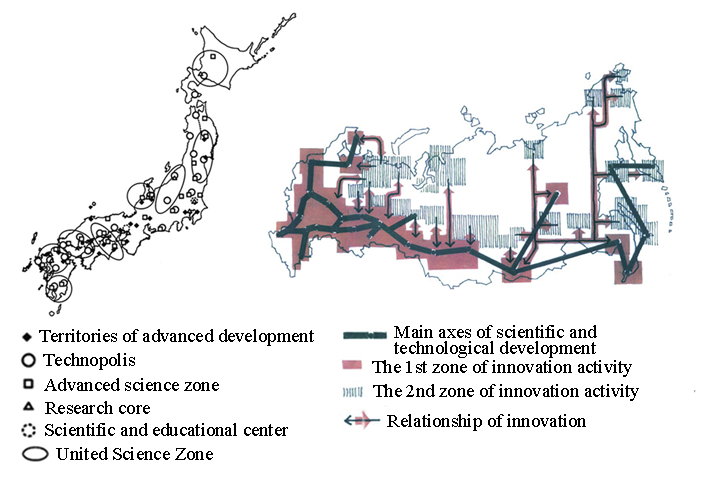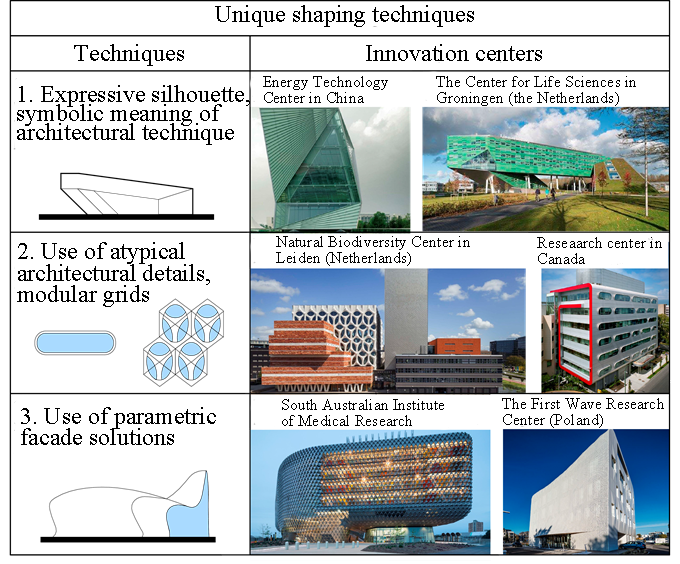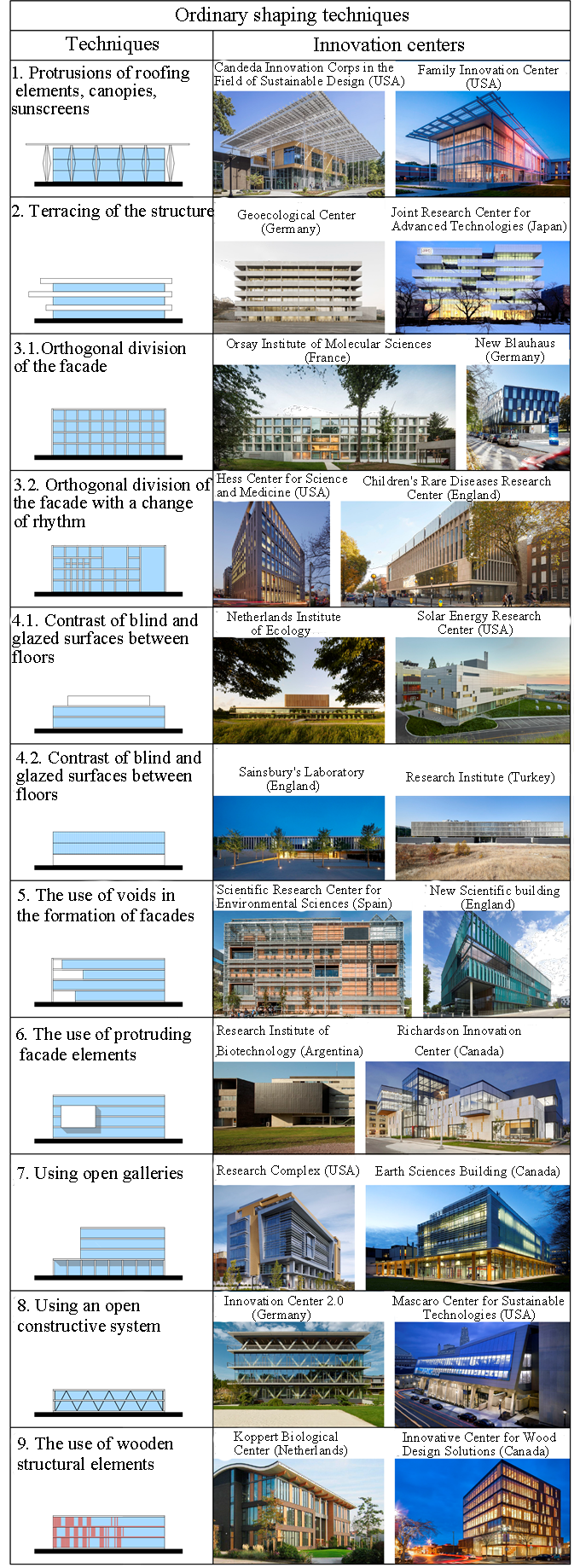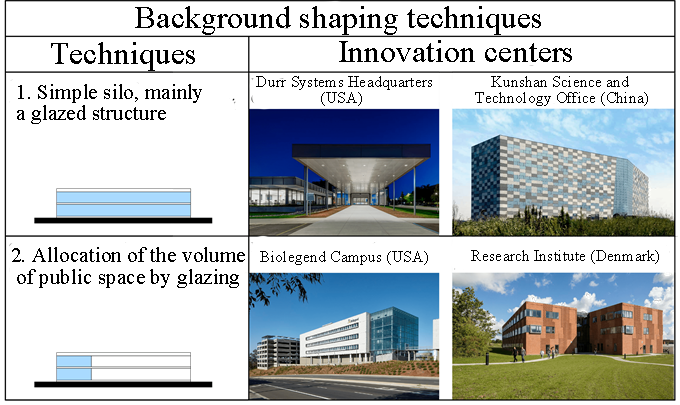|
MAIN PAGE
> Back to contents
Urban Studies
Reference:
Pochtovaia A.V.
The Design Solutions of Innovation Centers
// Urban Studies.
2023. № 4.
P. 50-61.
DOI: 10.7256/2310-8673.2023.4.69062 EDN: LTAUXZ URL: https://en.nbpublish.com/library_read_article.php?id=69062
The Design Solutions of Innovation Centers
Pochtovaia Anastasiia Vladimirovna
ORCID: 0000-0003-3630-1529
Senior lecturer, Department of Architectural Design, Institute of Architectural and Design, Siberian Federal University
660041, Russia, Krasnoyarsk Territory, Krasnoyarsk, Svobodny Ave., 82A

|
A9029652222@gmail.com
|
|
 |
Other publications by this author
|
|
|
DOI: 10.7256/2310-8673.2023.4.69062
EDN: LTAUXZ
Received:
21-11-2023
Published:
31-12-2023
Abstract:
The article examines the innovation center as an architectural object that creates conditions for research, cooperation between various economic entities and the production of knowledge-intensive products. The article subject is the design of innovation centers. The relevance of their consideration is due to the special attention of the state, the architectural community, and commercial enterprises. High quality of design solutions and symbolism of the architectural image are the basis for the innovation centers design, a competitive advantage in attracting and retaining highly skilled specialists. The study uses a graphic-analytical method and multifactor analysis of studying and systematizing the material (analysis of master plans, architectural drawings, engineering solutions). The contribution of the article consist in the identification and systematization of innovation centers architectural design solutions. The models of innovation centers design were made on urban, planning, and spatial characteristics of innovation centers. A computer program for data processing was used. The influence on the innovation centers design proceeds from organization structure, different types of ownership (university, government and commercial) and the location (city center, city district, suburbia, intercity territory). The total sample of the study consisted of 144 objects. It provides accurate result and the possibility of using the findings by professional architectural community.
Keywords:
innovation center, technopark, science park, architectural design, architecture, design conditions, space, innovation network, territory brand, innovation developing
This article is automatically translated.
You can find original text of the article here.
Introduction. Modern innovation centers are adapting to the conditions under which the economies of states respond to current challenges, such as a slowdown in labor productivity, the ongoing Covid 19 pandemic, etc. [1]. There is a demand for increasing the efficiency of scientific activity, improving research infrastructure, and preparing society for the perception and introduction of new technologies. "Trust in technology and willingness to use it depend, among other things, on trust in the institution that implements it ... taking into account regional socio-cultural characteristics" [2]. The innovation cycle, including scientific research, testing, production, commercialization, is a typed process typical for this type of facility, adjusted for the presence of industry specialization. The requirements for laboratories, the composition of the premises, engineering and technical equipment, recreation and communication areas are similar [3]. At the same time, the objects have architectural expressiveness and recognizability, they are centers of attraction. Therefore, it is necessary to consider the compositional and artistic structure of innovation centers in order to identify the presence of features, common architectural techniques that form a symbolic image of advanced science and contribute to the identification of objects in the urban environment [4]. Results. Understanding the architectural features of innovation centers is possible when comparing objects with each other, comparing with the surrounding buildings, studying the cultural context of the territory. The role of the facility in the country's innovation system, priority in the territorial development of regions is of no small importance (Fig.1). The cluster layout of innovation centers according to strategic initiatives allows attracting and retaining highly qualified personnel, increasing the efficiency of the scientific process due to the building of enterprise connections, the consolidated effect of educational and social functions of facilities [5]. 
Fig. 1. The map of the country's innovative development: a) Japan [6]; b) Russia [7] Architecture is a tool for stimulating innovation activity and building the brand of the territory. "Researchers, investors and clients correlate the reliability of their companies with architectural advantages" [8]. This thesis is confirmed by the development of innovation centers by such renowned architectural companies as Perkins&Will, Nikken Sekkei, BVN Architecture, Zaha Hadid Architects, etc. Thus, the study of architectural techniques will allow us to correlate compositional and artistic features with the tasks of spatial development. The analysis of 144 objects located in the USA, Canada, South America, Europe, Australia, and Asian countries made it possible to systematize the methods of architectural shaping of innovation centers into various groups: unique, ordinary and background. Unique innovation centers emphasize the importance of innovation for the development of the country, become a symbol, a visual dominant of the territory, contributing to the formation of its identity [9]. The group of techniques is most demanded in the USA and Australia, which have the lowest "brain drain" coefficient, characterizing the outflow of researchers from the country, 1.7 and 0.4, respectively [10]. The considered group includes techniques that are used both in shaping the appearance of the structure as a whole and public space (Fig.2): - the symbolic meaning of the architectural image, an expressive silhouette, the use of national architectural traditions and forms [11], the manifestation of the area of specialization of the innovation center or the visual characteristics of the customer's brand through the design of facades; - customized architectural details and modular grids; - parametric facade solutions. 
Fig. 2. Architectural techniques for shaping innovation centers. Unique A technique based on the symbolic meaning of the artistic image of the building is highlighted. The Biosciences Research Building has striking compositional features [12]. The architects developed the idea of biological specialization of the center, which is reflected in the use of the image of the X chromosome in the formation of the object (Fig.3a). Note Sengawa Kewport (Sengawa Kewport) is an innovation center in Japan, in the style of which the brand of the customer company is used, manifested in the structural structure of the object (Fig.3b) [13]. a  b b Fig.3. Architectural techniques for shaping innovation centers. Unique: a) The Research Building of Biological Sciences [12]; b) Sengawa Kewport [13] The most common compositional and artistic techniques for this type of object are at the heart of ordinary innovation centers (Fig.4). According to the data obtained, they have become most widespread in Western Europe and Japan. These include:
- the use of functional and energy-efficient elements (projections of roofing elements, canopies, sunscreens, vertical landscaping, etc.); - terracing the volume of the structure; - orthogonal division of facades (uniform or with a change of rhythm); - contrast of blind and glazed surfaces between floors; - the use of ledges or voids of the facade; - inclusion of open galleries and constructive systems; - the use of wooden structural and finishing materials. Compliance with international green standards can also be interpreted as an ordinary method of architectural shaping of innovation centers. Often, structures are certified according to LEED, BREAM, ABGR standards, etc. For example, such parameters as the inclusion of the natural environment in the internal and external organization of the building, which has a positive effect on labor productivity, and the reuse of materials for construction [14]. 
Fig. 4. Architectural techniques for shaping innovation centers. Privates Background innovation centers are part of the development of a cluster, campus, and industrial area and do not require the development of individual architectural solutions [15]. In the studied sample, the innovation centers of the USA and European countries are often based on the considered techniques under appropriate conditions, the dominance of the importance of functional processes (Fig.5). These include: - a simple silhouette with a glazed volume of the structure; - compositional allocation of the volume of the internal public space. 
Fig.5 Architectural techniques for shaping innovation centers. Background The systematization of innovation centers based on compositional and artistic solutions made it possible to identify the predominant urban planning, planning and spatial characteristics through computer data processing and compile architectural models for each group of techniques (Table 1). It seems important to compare the obtained models with the basic structural innovation center formulated as a result of previous studies (Fig.6) [16]. Table 1. Characteristics of innovation centers in relation to groups of shaping techniques | № | Specifications | Unique | Private | Background | Reconstruction |
| 1 | The area is average | 30.0 thousand m2 | 51.2 thousand m2 | 11.2 thousand m2 | 23.7 thousand m2 | | 2 | Region | Organic on the one hand | Organic on the one hand | Adjacent to the natural area | Organic on the one hand | | 3 | Planning structure | Block | Linear | Block | Compact | |
4 | External OP | Deep | Deep | Deep | Deep | | 5 | Number of floors | 3-6 floors | 3-6 floors | 3-6 floors | 3-6 floors | | 6 | Spatial structure | Multi - light central | Multi-light two or more | Multi-light two or more | Mezzanine | | 7 |
Internal OP | Around the atrium | Around the atrium | Around the atrium/ simple | Around the atrium | 
Fig. 6. Models of innovation centers with respect to groups of shaping techniques: a) basic; b) unique; c) ordinary; d) background; e) reconstruction From Figure 6, it can be concluded that the differences from the basic model are shown slightly in the transformation of the structure of the internal public space. Thus, the identified architectural shaping techniques are an artistic expression of the features of the innovation center, the established design experience, and a functional aspect of the production process of high-tech products. Therefore, it is necessary to consider the conditions under which their use would be appropriate. For example, the organizational structure, type of ownership, location of the site relative to the city. These parameters are fixed at the early stages of the development of objects, such as the formation of technical specifications, conceptual and conceptual design. The organizational structure of the innovation center is based on the functional aspect and includes 10 types [17]. Summarizing the data showed that architectural shaping techniques are most evident in such types as an innovation center, an open research park, a scientific and industrial park, and a technopark. The frequency of use of the techniques is illustrated in Table 2. Table 2. Methods of shaping innovation centers depending on the organizational structure | Techniques of architectural formation | Organizational structure | | Innovation Center, % | Scientific Research Park open/closed, % |
Scientific and Industrial Park, % | Technopark, % | | Unique | 41,0 | 46,2/5,1 | - | 8,3 | | Privates | 20,2 | 51,2/10,7 | - |
- | | Background | 13,3 | 60,0 | 20,0 | - | | Reconstruction | 33,3 | 50,0 | - | 16,7 |
It was also analyzed under which types of ownership (university, commercial, state) the selected groups of techniques are used (Table 3). Based on the data obtained, it can be concluded that ordinary techniques are widespread. The projects of innovation centers located on university campuses include unique techniques much more often than other forms of ownership due to the importance of forming the image of the territory, the representativeness of the educational institution. These techniques are least in demand in commercial buildings. Background shaping techniques are used much less frequently, the largest share of use is observed under state ownership of structures. Table 3. Methods of shaping innovation centers depending on the type of ownership | Techniques of architectural formation | Type of ownership | | University, % | Commercial, % | State-owned, % | | Unique | 32,3 | 19,5 | 26,3 | |
Privates | 53,8 | 68,3 | 55,3 | | Background | 9,2 | 9,8 | 13,2 | | Reconstruction | 4,6 | 2,4 | 5,3 |
Similarly, the influence of the location of the site of the innovation center on architectural shaping techniques was analyzed (Table 4). Unique objects predominate in the central part of the urban area, while other placement options mainly use ordinary techniques. It should be noted that the tendency to use background increases with distance from the urban center. Table 4. Methods of shaping innovation centers depending on the location of the site relative to the city | Techniques of architectural formation | The location of the site relative to the city | | The city center, % | The area of the city, % | Urban periphery, % | Intercity territory, % | | Unique | 52,6 | 21,7 |
25,6 | 22,7 | | Privates | 47,4 | 65,0 | 58,1 | 50,0 | | Background | - | 5,0 | 14,0 |
27,3 | | Reconstruction | - | 8,3 | 2,3 | - | Discussion. The results of identifying and systematizing the methods of shaping innovation centers are based on the analysis of an array of data and the natural conditions of application. At the same time, it should be noted that their use can be adjusted due to the preferences of architects, customers and investors, authorities, the availability of architectural and urban planning requirements and other regulatory documents. It should be noted that the methods of shaping structures during reconstruction were considered separately [18]. Conclusion. As a result of the conducted research, the architectural techniques of shaping innovation centers were identified and illustrated, which are divided into unique, ordinary and background ones. Models of innovation centers corresponding to the formed groups of techniques have been compiled. The models were compared with the basic structure, which allowed us to conclude that there was no significant influence of the identified techniques on the urban planning, planning and spatial characteristics of objects. The conditions of using architectural techniques for shaping innovation centers, which include the organizational structure, type of ownership and location of the construction site relative to the city, are studied. Unique techniques reflect the importance of the facility in the country's innovation system, they are often used in organizational types of innovation center and open research park, state or university ownership, located in the city center. Ordinary people are most in demand and form the image of structures of this type, contribute to their identification in the urban environment. Background objects are common in the form of an open research park, state-owned, often located in an intercity area and bordered by natural areas. Thus, the results of the study can be used in drawing up technical specifications, designing innovation centers as a starting point for achieving the goals of spatial development of the territory, forming its image and attracting highly qualified personnel in conditions of high professional mobility.
References
1. Global innovation Index 2022. Retrieved from https://www.wipo.int/edocs/pubdocs/en/wipo-pub-2000-2022-en-main-report-global-innovation-index-2022-15th-edition.pdf
2. Antonov, E. (2019). Sociocultural factors of innovative activity of the population. Moscow: Institute of National Projects, Russian venture company.
3. Appleton, N. (2014). Reserch building planning and design. UK: Design Media Publishing Limited.
4. Buxton, P. (2021). Metric handbook planning and design data: 7th edition. New York: Routledge.
5. Bocharov Y., Frezinskaya N., & Sergeyev K. (2019). City-Conducting Role of Innovation Activities. Academia. Architecture and Constraction, 4, 60-66. doi:10.22337/2077-9038-2019-4-60-67
6. Cha, S. (2016). Building STP’s Ecosystem: Kitakyushu Approach. Retrieved from https://link.springer.com/chapter/10.1007/978-1-4471-5508-9_22
7. Frezinskaya N. (2013). Perspective territorial organization of the innovation system of Russia. Bulletin of the Volgograd State University of Architecture and Civil Engineering, 31-1, 200-206.
8. Dianova-Klokova I., & Metanyev D. (2021). On the Architectural Solutions for Scientific and Innovation Objects. Academia. Architecture and Constraction, 1, 64-72.
9. Lynch K. (2021) The Image of the City. Мoscow: Strelka Press.
10. Human flight and brain drain-Country rankings. Retrieved from https://www.theglobaleconomy.com/rankings/human_flight_brain_drain_index/
11. Gelfond A., & Zhilina O. (2012 Архитектурно-планировочное формирование университетских кампусов (на примере пригорода Рангсит) [Architectural and planning design of university campuses (using the example of the Rangsit suburb)]. Bulletin of the Volzhsky regional branch of the Russian Academy of Architecture and Construction Sciences, 15, 40-46.
12. Biosciences research building. Retrieved from https://www.archdaily.com/289897/biosciences-research-building-lyons/5097d7a428ba0d49e600041b-biosciences-research-building-lyons-photo?next_project=no
13. Nikken journal 16. Retrieved from https://www.nikken.co.jp/en/about/p4iusj0000001i3q-att/NJ16_WEB.pdf
14. Dianova-Klokova I., & Metanyev D. (2022). The Green Continent – Green Architecture of Scientific and Innovative Complexes. Academia. Architecture and Constraction, 1, 37-45.
15. Weyer J., & Baragano S. (2013). Industrial building planning and design. UK: Design Media Publishing Limited.
16. Pochtovaya A. (2016). Innovation Complexes: Typological Aspects of Architectural formation. Fundamental Research, 11, 74-79.
17. Pochtovaya A. (2023). Conditions of Innovation Center Public Spaces Design. Prospect Svobodny – 2023 : proceedings of the XIX International Scientific Conference for undergraduate, postgraduate, PhD students and early career researchers. Krasnoyarsk, April 24–29, 2023 [Electronic resource]. edit. K. V. Kamalova. Krasnoyarsk: SibFU, 1048-1051.
18. Pochtovaya A. (2023). The Word Experience of Innovation Centers Architectiral Design. Город, пригодный для жизни [A city fit for life]: proceedings of the V nternational Scientific Conference, Krasnoyarsk, November 10–11, 2022. D.Е. Lemytskaya. Красноярск: Krasnoyarsk: SibFU, 412-416.
Peer Review
Peer reviewers' evaluations remain confidential and are not disclosed to the public. Only external reviews, authorized for publication by the article's author(s), are made public. Typically, these final reviews are conducted after the manuscript's revision. Adhering to our double-blind review policy, the reviewer's identity is kept confidential.
The list of publisher reviewers can be found here.
The topic of shaping as a whole is one of the fundamental in architectural typology, and accordingly the shaping of such modern facilities as innovation centers is also an urgent topic. The subject of this study is the architectural features of innovation centers, and the method is case study (case study), namely, the identification and formalization of architectural shaping techniques in conjunction with the spatial structure of structures, the possibilities of territory development, the formation of environmental identity and the involvement of highly qualified personnel. The criteria for the formation of three selected groups of innovation centers according to architectural shaping techniques — unique, environmental and background — were the importance of innovative processes for a particular country, the degree of uniqueness of architectural techniques, and location in the planning structure of the city. Based on the modeling of architectural techniques of a fairly representative group of existing objects around the world – 144, excluding Russia (apparently, we do not yet have achievements in this field), the author has clearly formulated a series of techniques that allow us to group them. The following architectural techniques are attributed to the unique group: expressiveness of the silhouette, symbolization of the image, use of national architectural traditions, individuality of architectural details, modularity; parameterism; The ordinary group (the most common) includes: functionalism and energy efficiency of elements; terracing of the volume of the structure; orthogonality of the division of facades; contrast of blind and glazed surfaces between floors; use of projections or facade voids; the inclusion of open galleries and structural systems; the use of wooden structural and finishing materials; compliance with international green standards. Techniques are assigned to the background group: simplicity of the silhouette with a glazed volume; accentuation of the internal public space. The techniques of shaping structures during reconstruction were considered separately. The novelty of this research includes the development of models of innovation centers of a particular group (unique, ordinary, background) and their comparison with the basic model (author's development at the previous stage). The comparison allowed us to draw an important conclusion that the identified architectural techniques of shaping will be appropriate under certain conditions, namely, under certain organizational structure of the enterprise, type of ownership and location of the site in the structure of the city. The author's generalization of data on the organizational structure of the centers made it possible to determine the frequency (in %) of using one or another group of architectural techniques. For example, unique techniques are used most often in innovation centers (41%), and background techniques in research parks (60%) (Table 2). The same generalizations were made by the author by type of ownership and depending on the location of the center in the city structure (Tables 3, 4). In As a result, there are natural trends in the use of certain groups of architectural techniques, including the case of reconstruction, which can be taken into account at the earliest stages of design (when drawing up technical specifications, when developing a sketch), which is the applied value of scientific research. At the same time, the author pointed out the existing adjustment of the use of techniques in view of objective conditions: the preferences of the architect, the customer, the investor, the authorities and other regulatory circumstances. The nature of the research and presentation indicates that the author has been dealing with this topic for a long time, knows leading domestic and foreign authors on architectural typology and directly on innovation centers. The style and structure of the presentation fully corresponds to the genre of the scientific article. In the reviewer's opinion, "environmental" and "background" objects are essentially the same thing. In any case, this is how it is accepted when characterizing historical buildings, which are generally "environmental" or "background" for attractions, cultural heritage sites. But in this case, the groups of architectural techniques "environmental" and "background" are different, and the author has the right to define them. There are minor technical remarks, typos and typos: "the group of techniques is most demanded in the USA and Australia ..." – it is necessary: in demand, "according to the data received, they received ..." — repeat "orthogonal division" — it is necessary: division "from the basic structural innovation center" – it is necessary: structure
Link to this article
You can simply select and copy link from below text field.
|
|




